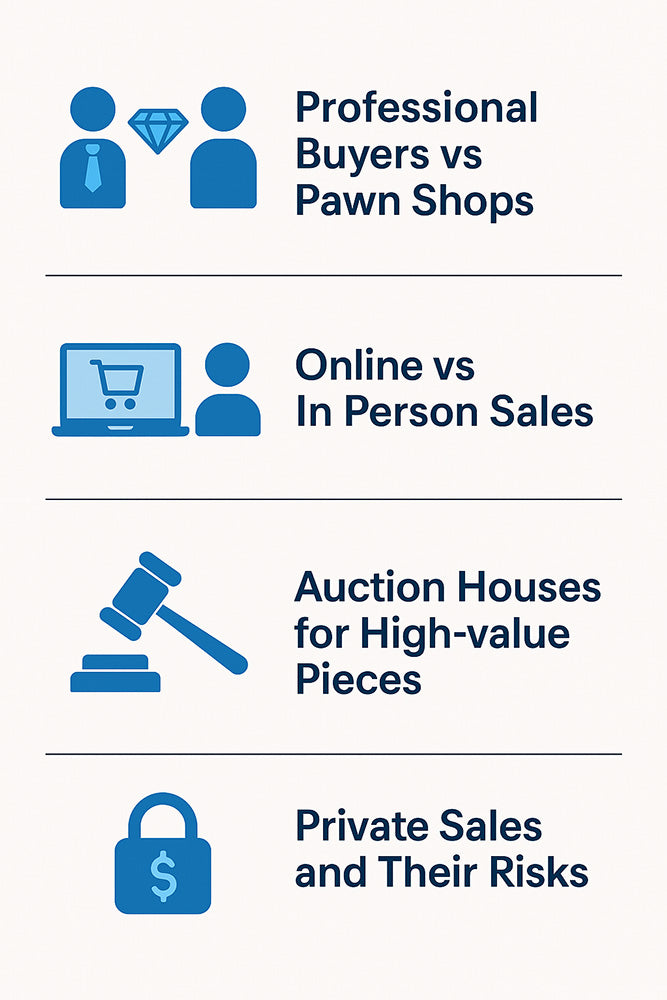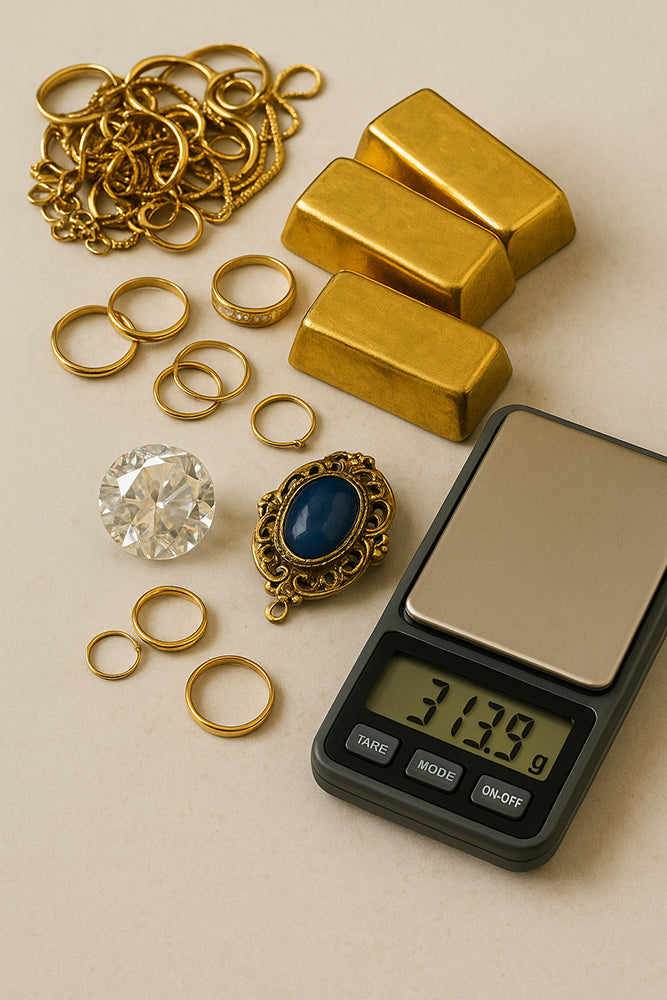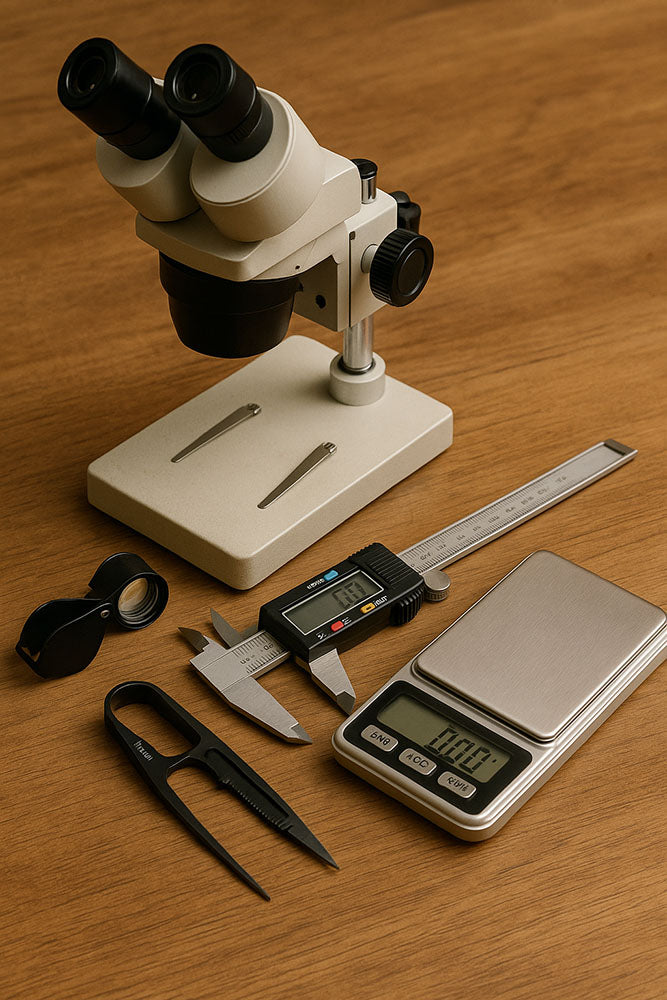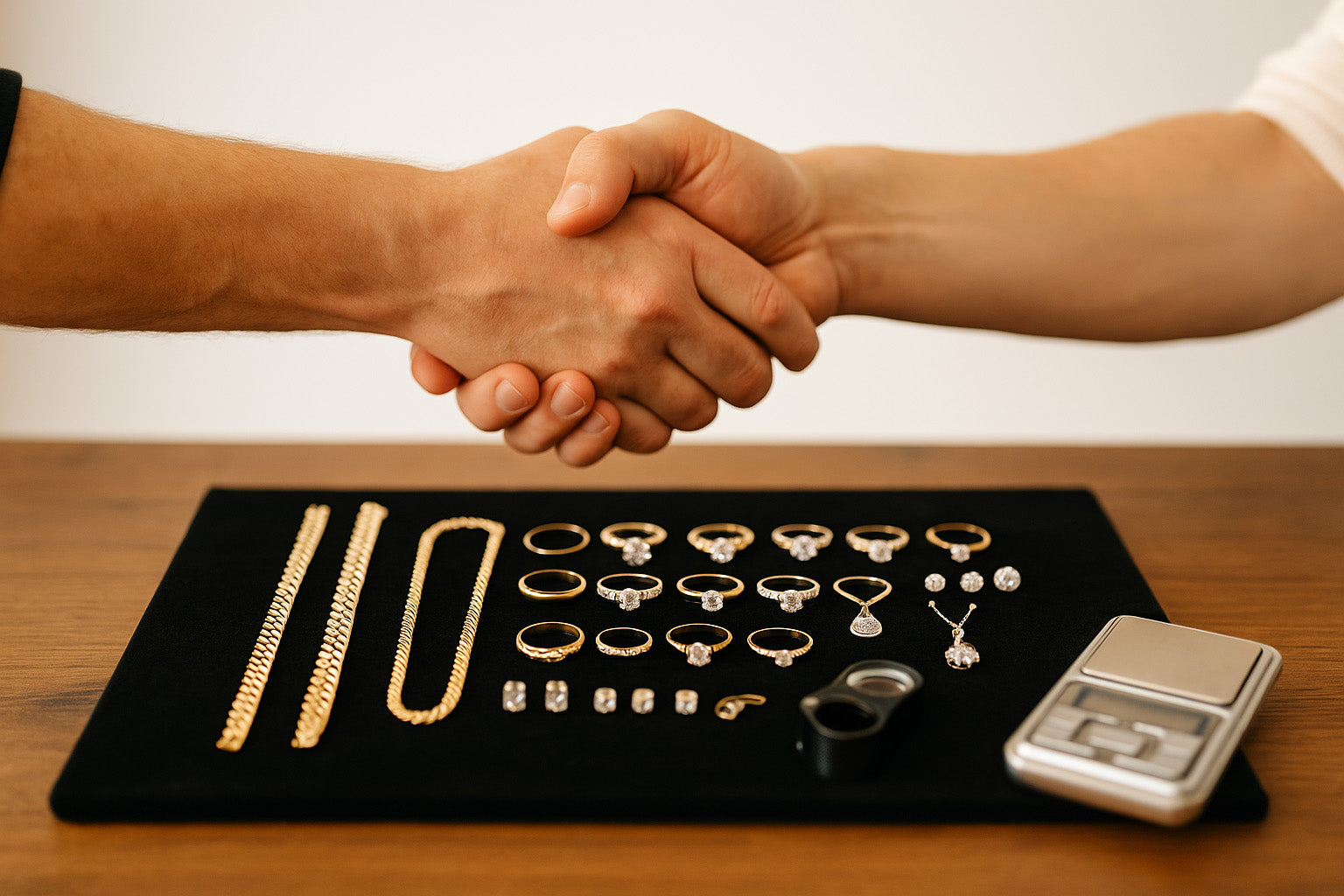A no-nonsense guide to selling your diamonds, jewellery and gold
Selling diamonds, gold, and jewellery can feel overwhelming - especially when you're dealing with estate settlements, divorce proceedings, or simply parting with pieces that hold sentimental value. We understand how challenging this process can be, which is why we've created this straightforward guide to help you understand your options and know what to expect.
At Jewelco, we've been providing professional, no-pressure jewellery buying services from our Rose Bay location in Sydney's Eastern Suburbs. We believe that knowledge empowers better decisions, so whether you ultimately choose to work with us or someone else, this guide will help you navigate the process with confidence.
Table of Contents
We've organized the information in this guide into clear sections so you can find what you need quickly. Use the index below to jump to any specific topic.
- Your Selling Options
Explore the different ways to sell your gold, diamonds, and jewellery, and learn the pros and cons of each. - Know Your Items' True Value
Understand how diamonds, gold purity, designer brands, and antiques affect the value of your items. - Assessing a Prospective Buyer
Learn what to look for in a trustworthy buyer and red flags to avoid during the selling process. - The Valuation Process
Get familiar with how professionals test and price your items, and the documentation you should expect.

Your Selling Options
Professional Buyers vs. Pawn Shops
Professional precious metals and jewellery buyers focus specifically on accurate valuations and fair pricing, employing certified gemmologists and using professional-grade testing equipment. They typically offer higher prices because they understand true market value and work on smaller margins.
Pawn shops, on the other hand, are primarily lending businesses that need to price items conservatively to protect against loan defaults. While pawn shops offer convenience and immediate cash, they often lack specialised expertise in fine jewellery and diamonds, resulting in significantly lower offers.
Professional buyers also provide detailed documentation and explanations of their pricing, whereas pawn shops may offer little transparency in their valuation process.
Online vs. In-Person Sales
Selling in person allows you to watch the evaluation process, ask questions immediately, and receive payment on the spot. You can see exactly how your items are tested and build confidence through face-to-face interaction. Online sales can sometimes offer competitive prices due to lower overhead costs, but they require shipping valuable items to strangers, often with limited insurance coverage. You'll also need to rely on photos and descriptions rather than professional, hands-on evaluation. While some reputable online buyers exist, the lack of personal interaction makes it harder to assess their credibility, and return processes can be complicated if you're unsatisfied with their offer.
Auction Houses for High-Value Pieces
Auction houses can be excellent for truly exceptional pieces—rare diamonds, signed designer jewellery, or significant antique pieces that might attract collectors. They have access to specialised buyers willing to pay premium prices for unique items. However, auction houses charge substantial fees (typically 10-25%), have long timelines (often 3-6 months from consignment to payment), and there's no guarantee your item will sell or meet reserve prices. They're also selective about what they'll accept, often requiring pieces valued at several thousand dollars minimum. For most everyday gold jewellery and standard diamonds, auction houses aren't practical or profitable due to their fee structure and specialised focus.
Private Sales and Their Risks
Selling directly to individuals through classified ads or social media can potentially yield higher prices since you're eliminating the middleman's profit margin. However, private sales come with significant risks including personal safety concerns when meeting strangers with valuable items, potential for counterfeit payment methods, and lack of legal protections if disputes arise. You'll also need to handle your own marketing, scheduling, and negotiations, which can be time-consuming. Most importantly, private buyers often lack the expertise to properly value fine jewellery and diamonds, so you may not actually receive better offers despite the additional risks and effort involved.

Know Your Items' True Value
Common Misconceptions About Value
Many people overestimate their jewellery's value based on what they paid originally or insurance appraisals, which are typically inflated for replacement purposes rather than resale value. Sentimental value, unfortunately, doesn't translate to market value. Another common misconception is that all diamonds are valuable - small, low-quality diamonds (often called "chips" or "melee") have minimal resale value. Similarly, gold-plated or gold-filled items contain very little actual gold and aren't worth much to buyers. Finally, many assume that because a piece is "real" gold or diamonds, it automatically has significant value - but quality, size, and market demand all play crucial roles in determining what buyers will actually pay.
How Diamonds Are Valued (4 Cs Explained Simply)
Diamond value comes down to four main factors: Cut (how well the diamond reflects light), Color (less colour usually means more valuable), Clarity (fewer internal flaws means higher value), and Carat weight (bigger isn't always better if the other factors are poor). The most important thing to understand is that these factors work together - a large diamond with poor cut and clarity might be worth less than a smaller stone with excellent grades. Certified diamonds come with grading reports from labs like GIA that document these characteristics. Without certification, even experienced buyers need to make educated estimates, which typically means more conservative offers to account for uncertainty.
Gold Purity and Weight Basics
Gold jewellery is measured in karats (not to be confused with diamond carats), which indicates purity. 24k is pure gold, 18k is 75% gold, 14k is 58.3% gold, and 10k is 41.7% gold. The higher the karat, the more valuable your piece will be per gram. However, total value depends on both purity and weight - a heavy 14k bracelet might be worth more than a delicate 18k ring. Gold buyers use electronic testers or acid tests to verify purity, then weigh your items on precise scales. Current gold prices fluctuate daily, so timing can affect your final offer, though these changes are usually gradual rather than dramatic.
Designer vs. Non-Designer Pieces
Pieces from renowned designers like Cartier, Tiffany, or Van Cleef & Arpels can command significant premiums beyond their metal and stone values, especially if they're from popular collections or discontinued lines. However, this premium only applies when pieces are authentic, in good condition, and preferably come with original boxes and certificates. Lesser-known designer names typically don't add much value in the resale market. Most buyers focus primarily on the intrinsic value of the materials (gold weight, diamond quality) rather than design premiums, unless they specialise in luxury resale. If you believe you have high-end designer pieces, it's worth getting multiple opinions to ensure you're receiving appropriate recognition for the brand value.
Antique and Vintage Considerations
Antique (over 100 years old) and vintage (roughly 20-100 years old) jewellery can be worth significantly more than their material value if they represent important periods, styles, or craftsmanship. Art Deco pieces from the 1920s, Victorian mourning jewellery, or mid-century modern designs often attract collectors willing to pay premiums. However, age alone doesn't guarantee added value - the piece needs to be historically significant, well-preserved, or represent exceptional craftsmanship. Many buyers don't specialise in antique jewellery and may only offer material value, so consider consulting antique jewellery specialists or appraisers if you suspect your pieces have historical significance.

Assessing a Prospective Buyer
What to Look for in a Buyer
Professional buyers demonstrate transparency and credibility through several key characteristics:
Business Credentials:
- Permanent physical location you can visit
- Proper business licensing clearly displayed
- Professional insurance coverage
- Certifications from gemological institutes or precious metals associations
Professional Equipment & Process:
- Visible, professional testing equipment (electronic gold testers, diamond scales, loupes)
- Step-by-step explanation of their evaluation process
- Allow you to watch while they test your items
- Detailed breakdowns of how they calculated offers
Customer Service Standards:
- Give you time to consider offers without pressure
- Willing to answer all questions thoroughly
- Provide written documentation and proper receipts
- Positive online reviews from multiple verified sources
- Secure, insured handling of valuable items
Red Flags - What to Avoid
Stay away from buyers who exhibit these warning signs:
Pressure Tactics:
- "Limited time offers" or demands to sell immediately
- Unrealistic promises about item values
- Pushy or aggressive sales approaches
Lack of Transparency:
- Won't let you watch the testing process
- Refuse to explain pricing methodology
- Can't or won't show you their testing equipment
- Quote prices before properly examining items
Unprofessional Operations:
- Operating from temporary locations (hotels, car parks)
- No proper business licenses displayed
- Ask you to meet in unusual or unsafe locations
- No verifiable business address or contact information
Poor Documentation:
- Won't provide written estimates or detailed receipts
- No insurance coverage for your items
- Evasive when asked about business experience
- Predominantly negative online reviews
- Use outdated or questionable testing methods

The Valuation Process
What Legitimate Testing Looks Like
Professional testing should be conducted openly where you can observe the entire process. For gold, buyers will use electronic gold testers or careful acid testing on inconspicuous areas, explaining each step as they work. Diamond testing involves examining stones under proper lighting with a loupe or microscope, checking for authenticity with diamond testers, and measuring dimensions for carat weight estimates. Legitimate buyers will handle your items carefully, use clean testing surfaces, and take time for thorough evaluation rather than rushing through the process. They should also test multiple areas on gold pieces to ensure consistent purity throughout, especially on older or suspicious items.
Questions You Should Ask
Ask to see their testing equipment and have them explain how it works. Request that they walk you through their evaluation process step-by-step, including how they're determining karat content, diamond grades, and overall condition assessments. Find out what percentage of current market prices they typically pay and whether their offers include any fees or deductions. Ask about their experience with your specific type of items, especially for antique pieces or designer jewellery. Also inquire about their return policy, payment methods available, and how long you have to consider their offer before it expires.
Understanding Pricing Calculations
Buyers should clearly explain how they arrive at their offers, starting with current market prices for gold and diamonds. For gold, they'll calculate based on pure metal content (karat × weight × current gold price), then apply their buying percentage, which typically ranges from 70-90% of spot price depending on the buyer and item condition. Diamond pricing is more complex, involving the 4 Cs evaluation, but buyers should explain their quality assessments and reference current market comparisons. Any deductions for damage, wear, or processing costs should be clearly itemized and justified rather than presented as mysterious "handling fees."
Getting Multiple Opinions When Appropriate
Seek multiple evaluations when dealing with high-value items (generally over $1,000), pieces you suspect might have special significance, or when initial offers seem unusually low or high. Antique jewellery, designer pieces, or items with large centre stones especially benefit from multiple professional opinions. However, for standard gold jewellery or small diamonds, one reputable buyer's assessment is usually sufficient. When getting multiple opinions, visit buyers within a short timeframe since gold prices fluctuate daily. Don't feel obligated to accept the highest offer automatically - consider the buyer's professionalism and reputation alongside their pricing.
Documentation You Should Receive
Professional buyers provide detailed written documentation including item descriptions, tested karat content, weights, and calculated values for each piece. You should receive a formal purchase agreement or receipt that includes the buyer's business information, transaction date, payment method, and total amount paid. For valuable items, request documentation of the testing results and quality assessments performed. This paperwork serves as proof of transaction for tax purposes and provides protection if any disputes arise later. Legitimate buyers will also provide their business cards and contact information, making themselves available for any follow-up questions about the transaction.

Our Buying Service
Why sell your jewellery to Jewelco?
We're not a pawn shop or quick-cash gold buyer. We're professionals who have spent over 60 years combined working with diamonds, gold and fine jewelry. And we are jewellers specialising in creating custom jewellery. This means we understand the true value of quality pieces and can spot details that others might miss.
When you come to us, there's no pressure to sell and no pushy sales tactics. We take the time to explain what we're seeing, answer all your questions, and help you understand your options. You're welcome to think it over, get a second opinion, or simply walk away - that's completely fine with us.
Our goal is to help you navigate this process with confidence. Whether you decide to sell or not, you'll leave knowing exactly what you have and what it's worth. That's the difference between working with experienced professionals who care about getting it right versus businesses that are just focused on making quick deals.




